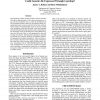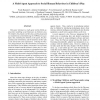628 search results - page 35 / 126 » Specifying Multiagent Organizations |
SCIE
1997
Springer
14 years 2 months ago
1997
Springer
Abstract. The task of information extraction can be seen as a problem of semantic matching between a user-defined template and a piece of information written in natural language. T...
AAAI
2000
13 years 11 months ago
2000
Self-organizing models develop realistic cortical structures when given approximations of the visual environment as input, and are an effective way to model the development of fac...
AOSE
2003
Springer
14 years 3 months ago
2003
Springer
This paper shows how to verify a Multi-Agent System specification using human organization metaphors. This proposal applies Activity Theory, which has its roots in Sociology, to st...
IAT
2006
IEEE
14 years 4 months ago
2006
IEEE
This paper introduces a multi-agent system (MAS) approach for modelling social behaviours in children’s play. The children, the dynamics of their play, and the playground are mo...
CMOT
1998
13 years 9 months ago
1998
A programming language which is optimized for modelling multi-agent interaction within articulated social structures such as organizations is described with several examples of it...


